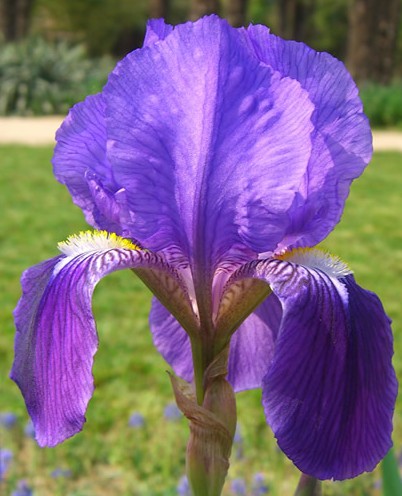 Also known as bearded iris and common flag, this herbaceous perennial is native to the eastern Mediterranean and may be a natural hybrid between Iris pallida and Iris variegata. It is best known by its multitude of cultivars that exhibit great variety height of plant and color and size of flowers. Plants grow from creeping rhizomes that may for large clumps and may be less than 8″ or up to 38″ tall. The leaves are sword shaped and mostly basal. Up to six flowers appear in the spring on flowering stalks and consist of three upright “petals” called standards, and three drooping “petals” called falls that display a beard. The wild form of german iris has lilac standards and purple falls with white bases, brown veins and yellow beards but cultivars display a wide range of blues, purples, yellows, and pinks for all flower parts. Some flowers are fragrant and some plants rebloom in the fall. Plants produce a stunning display in the sping and the flowers are beautiful in the vase but are short lived. The genus name, Iris, honors the Greek goddess of the rainbow due to the huge variation in flower color. The specific epithet, geramica, refers to Germany one of the many places the plant has naturalized.
Also known as bearded iris and common flag, this herbaceous perennial is native to the eastern Mediterranean and may be a natural hybrid between Iris pallida and Iris variegata. It is best known by its multitude of cultivars that exhibit great variety height of plant and color and size of flowers. Plants grow from creeping rhizomes that may for large clumps and may be less than 8″ or up to 38″ tall. The leaves are sword shaped and mostly basal. Up to six flowers appear in the spring on flowering stalks and consist of three upright “petals” called standards, and three drooping “petals” called falls that display a beard. The wild form of german iris has lilac standards and purple falls with white bases, brown veins and yellow beards but cultivars display a wide range of blues, purples, yellows, and pinks for all flower parts. Some flowers are fragrant and some plants rebloom in the fall. Plants produce a stunning display in the sping and the flowers are beautiful in the vase but are short lived. The genus name, Iris, honors the Greek goddess of the rainbow due to the huge variation in flower color. The specific epithet, geramica, refers to Germany one of the many places the plant has naturalized.
Type: Herbaceous perennial
Bloom: Spring flowers with 3 upright petals and 3 dropping petals that have a beard in blue. purple, white, yellow, and pink
Size: Less thatn 8 ” -38″ H x 1-2′ W
Light: Full sun; tolerates some shade
Soil: Average,moderatly moist, well-drained
Hardiness: Zones 5-9
Care: Deadhead, remove flower stalks out after blooming, divide when necessary, about every 3-4 years after flowering
Pests and Diseases: Iris borer, bacteial soft rot, crown rot fungus, fungal leaf spot, mosaic virus
Propagation: Division after flowering
Companion Plants:Cranesbill ‘Johnson Blue’, Salvia ‘May Night’, Lavender ‘Hidcote’, Alium ‘Purple Sensation’
Outstanding Selections: Hundreds of excellent cultivars are available